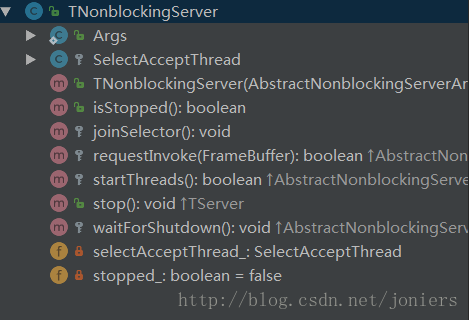概述
聊聊Thrift(四) thrift 服务篇-TNonblockingServer
TNonblockingServer是thrift提供的NIO实现的服务模式,提供非阻塞的服务处理,用一个单线程来处理所有的RPC请求。
类关系如下:

AbstractNonblockingServer是TNonblockingServer和TThreadedSelectorServer的父类,TThreadedSelectorServer即为我们下篇将要讲解的高级非阻塞模式
class结构如下图:

Args是静态内部类,用于传递参数,通过Args可以设置读缓冲区大小,序列化方式,传输协议以及RPC处理类。
通过AbstractNonblockingServer 的serve方法,启动服务,启动接受线程,启动监听,等待服务结束
/**
* Begin accepting connections and processing invocations.
*/
public void serve() {
// start any IO threads
if (!startThreads()) {
return;
}
// start listening, or exit
if (!startListening()) {
return;
}
setServing(true);
// this will block while we serve
waitForShutdown();
setServing(false);
// do a little cleanup
stopListening();
}重点需要我们关注的是startThreads,在startThreads的实现中,会创建一个SelectAcceptThread线程,并启动。
protected boolean startThreads() {
// start the selector
try {
selectAcceptThread_ = new SelectAcceptThread((TNonblockingServerTransport)serverTransport_);
return true;
} catch (IOException e) {
LOGGER.error("Failed to start selector thread!", e);
return false; }
}
SelectAcceptThread就是我们的NIO处理线程,用来accept客户端连接,读写请求
流程:startThreads-》SelectAcceptThread-》select
其中select用来处理所有io事件,select通过selector.select()等待IO事件,然后通过handleAccept、handleRead、handleWrite处理接收到的事件。
if (key.isAcceptable()) {
handleAccept();
} else if (key.isReadable()) {
// deal with reads
handleRead(key);
} else if (key.isWritable()) {
// deal with writes
handleWrite(key);
} else {
LOGGER.warn("Unexpected state in select! " + key.interestOps());
}由于TNonblockingServer是用一个SelectAcceptThread处理所有的请求,在并发场景下,其他的IO事件只能等待当前线程依次处理,处理效率略低。
这里记录一下handleRead的处理流程:
protected void handleRead(SelectionKey key) {
FrameBuffer buffer = (FrameBuffer) key.attachment();
//将channel中数据读取到buffer中
if (!buffer.read()) {
cleanupSelectionKey(key);
return;
}
// if the buffer's frame read is complete, invoke the method.
//判断一帧的数据是否读取完成,读取完成就调用相关的方法,执行rpc调用
if (buffer.isFrameFullyRead()) {
if (!requestInvoke(buffer)) {
cleanupSelectionKey(key);
}
}
}
在buffer.read()中完成实在数据的读取,根据FrameBuffer的状态,分为几部分读取
FrameBufferState.READING_FRAME_SIZE 初始状态,标识读取帧大小,该步完成,状态变更为:FrameBufferState.READING_FRAME
FrameBufferState.READING_FRAME 标识读取实际帧内容,该步完成,状态变更为:FrameBufferState.READ_FRAME_COMPLETE
public boolean read() {
//读取帧大小
if (state_ == FrameBufferState.READING_FRAME_SIZE) {
// try to read the frame size completely
if (!internalRead()) {
return false;
}
// if the frame size has been read completely, then prepare to read the
// actual frame.
if (buffer_.remaining() == 0) {
// pull out the frame size as an integer.
int frameSize = buffer_.getInt(0);
if (frameSize <= 0) {
LOGGER.error("Read an invalid frame size of " + frameSize
+ ". Are you using TFramedTransport on the client side?");
return false;
}
// if this frame will always be too large for this server, log the
// error and close the connection.
if (frameSize > MAX_READ_BUFFER_BYTES) {
LOGGER.error("Read a frame size of " + frameSize
+ ", which is bigger than the maximum allowable buffer size for ALL connections.");
return false;
}
// if this frame will push us over the memory limit, then return.
// with luck, more memory will free up the next time around.
if (readBufferBytesAllocated.get() + frameSize > MAX_READ_BUFFER_BYTES) {
return true;
}
// increment the amount of memory allocated to read buffers
readBufferBytesAllocated.addAndGet(frameSize + 4);
// reallocate the readbuffer as a frame-sized buffer
buffer_ = ByteBuffer.allocate(frameSize + 4);
buffer_.putInt(frameSize);
state_ = FrameBufferState.READING_FRAME;
} else {
// this skips the check of READING_FRAME state below, since we can't
// possibly go on to that state if there's data left to be read at
// this one.
return true;
}
}
// it is possible to fall through from the READING_FRAME_SIZE section
// to READING_FRAME if there's already some frame data available once
// READING_FRAME_SIZE is complete.
//读取帧大小完成,读取实际的帧数据
if (state_ == FrameBufferState.READING_FRAME) {
if (!internalRead()) {
return false;
}
// since we're already in the select loop here for sure, we can just
// modify our selection key directly.
if (buffer_.remaining() == 0) {
// get rid of the read select interests
selectionKey_.interestOps(0);
//标识读取帧完成,可以进行下一步
state_ = FrameBufferState.READ_FRAME_COMPLETE;
}
return true;
}
// if we fall through to this point, then the state must be invalid.
LOGGER.error("Read was called but state is invalid (" + state_ + ")");
return false;
}帧读取完成后,调用requestInvoke调用相关的方法,执行RPC调用
/**
* Actually invoke the method signified by this FrameBuffer.
*/
public void invoke() {
frameTrans_.reset(buffer_.array());//设置transport的缓冲区
response_.reset();//响应缓冲区清零
try {
if (eventHandler_ != null) {
eventHandler_.processContext(context_, inTrans_, outTrans_);
}
// 实际调用,通过getProcessor获取服务启动时设置的processor,这个processor是我们通过thrift的接口*.thrift编译生成的类里面的处理类
processorFactory_.getProcessor(inTrans_).process(inProt_, outProt_);
//响应结果
responseReady();
return;
} catch (TException te) {
LOGGER.warn("Exception while invoking!", te);
} catch (Throwable t) {
LOGGER.error("Unexpected throwable while invoking!", t);
}
// This will only be reached when there is a throwable.
state_ = FrameBufferState.AWAITING_CLOSE;
requestSelectInterestChange();
}通过 processorFactory_.getProcessor(inTrans_)获取到我们设置的处理类,然后process进行解析处理,首先解析message里面的信息,获取msg,然后通过msg.name获得processMap中对应的处理类,例如echo方法对应的映射关系:
processMap.put(“echo”, new echo());
获取到处理类之后,调用process进行处理,如fn.process(msg.seqid, in, out, iface)
@Override
public boolean process(TProtocol in, TProtocol out) throws TException {
//获取msg
TMessage msg = in.readMessageBegin();
//获取实际的处理方法
ProcessFunction fn = processMap.get(msg.name);
if (fn == null) {
TProtocolUtil.skip(in, TType.STRUCT);
in.readMessageEnd();
TApplicationException x = new TApplicationException(TApplicationException.UNKNOWN_METHOD, "Invalid method name: '"+msg.name+"'");
out.writeMessageBegin(new TMessage(msg.name, TMessageType.EXCEPTION, msg.seqid));
x.write(out);
out.writeMessageEnd();
out.getTransport().flush();
return true;
}
//调用处理方法,进行消息处理
fn.process(msg.seqid, in, out, iface);
return true;
}消息处理的方法见下:
public final void process(int seqid, TProtocol iprot, TProtocol oprot, I iface) throws TException {
T args = getEmptyArgsInstance();
try {
args.read(iprot);
} catch (TProtocolException e) {
iprot.readMessageEnd();
TApplicationException x = new TApplicationException(TApplicationException.PROTOCOL_ERROR, e.getMessage());
oprot.writeMessageBegin(new TMessage(getMethodName(), TMessageType.EXCEPTION, seqid));
x.write(oprot);
oprot.writeMessageEnd();
oprot.getTransport().flush();
return;
}
iprot.readMessageEnd();
TBase result = null;
try {
//实际的方法调用,会直接调用RPC接口的实际实现
result = getResult(iface, args);
} catch(TException tex) {
LOGGER.error("Internal error processing " + getMethodName(), tex);
TApplicationException x = new TApplicationException(TApplicationException.INTERNAL_ERROR,
"Internal error processing " + getMethodName());
oprot.writeMessageBegin(new TMessage(getMethodName(), TMessageType.EXCEPTION, seqid));
x.write(oprot);
oprot.writeMessageEnd();
oprot.getTransport().flush();
return;
}
//处理返回结果,通过oprot将结果序列化,有客户端进行解析
if(!isOneway()) {
oprot.writeMessageBegin(new TMessage(getMethodName(), TMessageType.REPLY, seqid));
result.write(oprot);
oprot.writeMessageEnd();
oprot.getTransport().flush();
}
}这里对getResult(iface, args)做一下简单描述,以echo接口为例:
public static class echo<I extends Iface> extends org.apache.thrift.ProcessFunction<I, echo_args> {
public echo() {
super("echo");
}
public echo_args getEmptyArgsInstance() {
return new echo_args();
}
protected boolean isOneway() {
return false;
}
public echo_result getResult(I iface, echo_args args) throws org.apache.thrift.TException {
echo_result result = new echo_result();
//调用echo的实现
result.success = iface.echo(args.reqId, args.caller, args.srcStr, args.ext);
return result;
}
}通过iface.echo(args.reqId, args.caller, args.srcStr, args.ext)的调用,我们实现了实际的echo接口的调用,然后通过oprot将返回结果序列化,写入缓冲区。
responseReady方法将结果放入nio的缓冲区,然后通过selectionKey_.interestOps(SelectionKey.OP_WRITE);设置写事件,触发NIO write操作,由handle_write将结果返回给客户端。
最后
以上就是慈祥信封为你收集整理的聊聊Thrift(四) thrift 服务篇-TNonblockingServer聊聊Thrift(四) thrift 服务篇-TNonblockingServer的全部内容,希望文章能够帮你解决聊聊Thrift(四) thrift 服务篇-TNonblockingServer聊聊Thrift(四) thrift 服务篇-TNonblockingServer所遇到的程序开发问题。
如果觉得靠谱客网站的内容还不错,欢迎将靠谱客网站推荐给程序员好友。








发表评论 取消回复